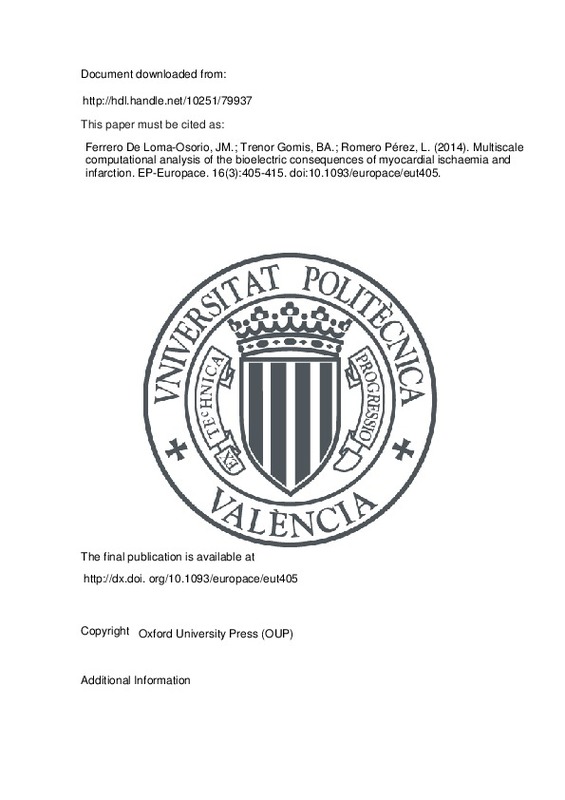JavaScript is disabled for your browser. Some features of this site may not work without it.
Buscar en RiuNet
Listar
Mi cuenta
Estadísticas
Ayuda RiuNet
Admin. UPV
Multiscale computational analysis of the bioelectric consequences of myocardial ischaemia and infarction
Mostrar el registro sencillo del ítem
Ficheros en el ítem
| dc.contributor.author | Ferrero De Loma-Osorio, José María
|
es_ES |
| dc.contributor.author | Trénor Gomis, Beatriz Ana
|
es_ES |
| dc.contributor.author | Romero Pérez, Lucia
|
es_ES |
| dc.date.accessioned | 2017-04-25T12:28:21Z | |
| dc.date.available | 2017-04-25T12:28:21Z | |
| dc.date.issued | 2014-03 | |
| dc.identifier.issn | 1099-5129 | |
| dc.identifier.uri | http://hdl.handle.net/10251/79937 | |
| dc.description.abstract | [EN] Ischaemic heart disease is considered as the single most frequent cause of death, provoking more than 7 000 000 deaths every year worldwide. A high percentage of patients experience sudden cardiac death, caused in most cases by tachyarrhythmic mechanisms associated to myocardial ischaemia and infarction. These diseases are difficult to study using solely experimental means due to their complex dynamics and unstable nature. In the past decades, integrative computational simulation techniques have become a powerful tool to complement experimental and clinical research when trying to elucidate the intimate mechanisms of ischaemic electrophysiological processes and to aid the clinician in the improvement and optimization of therapeutic procedures. The purpose of this paper is to briefly review some of the multiscale computational models of myocardial ischaemia and infarction developed in the past 20 years, ranging from the cellular level to whole-heart simulations. | es_ES |
| dc.description.sponsorship | This work was partially supported by the 'VI Plan Nacional de Investigacion Cientifica, Desarrollo e Innovacion Tecnologica' from the Ministerio de Economia y Competitividad of Spain (grant number TIN2012-37546-C03-01) and the European Commission (European Regional Development Funds-ERDF-FEDER), and by the Direccion General de Politica Cientifica de la Generalitat Valenciana (grant number GV/2013/119). | |
| dc.language | Inglés | es_ES |
| dc.publisher | Oxford University Press (OUP) | es_ES |
| dc.relation.ispartof | EP-Europace | es_ES |
| dc.rights | Reserva de todos los derechos | es_ES |
| dc.subject | Ischaemia | es_ES |
| dc.subject | Infarction | es_ES |
| dc.subject | Computer simulations | es_ES |
| dc.subject | Mathematical models | es_ES |
| dc.subject | Reentrant arrhythmias | es_ES |
| dc.subject.classification | TECNOLOGIA ELECTRONICA | es_ES |
| dc.title | Multiscale computational analysis of the bioelectric consequences of myocardial ischaemia and infarction | es_ES |
| dc.type | Artículo | es_ES |
| dc.identifier.doi | 10.1093/europace/eut405 | |
| dc.relation.projectID | info:eu-repo/grantAgreement/MINECO//TIN2012-37546-C03-01/ES/CORAZON HUMANO COMPLETO FISIOLOGICO VIRTUAL: MEJORAS EN EL TRATAMIENTO DE ARRITMIAS CARDIACAS ORIENTADO A PACIENTE/ | es_ES |
| dc.relation.projectID | info:eu-repo/grantAgreement/GVA//GV%2F2013%2F119/ | es_ES |
| dc.rights.accessRights | Abierto | es_ES |
| dc.contributor.affiliation | Universitat Politècnica de València. Escuela Técnica Superior de Ingenieros Industriales - Escola Tècnica Superior d'Enginyers Industrials | es_ES |
| dc.contributor.affiliation | Universitat Politècnica de València. Escuela Técnica Superior de Ingeniería del Diseño - Escola Tècnica Superior d'Enginyeria del Disseny | es_ES |
| dc.description.bibliographicCitation | Ferrero De Loma-Osorio, JM.; Trénor Gomis, BA.; Romero Pérez, L. (2014). Multiscale computational analysis of the bioelectric consequences of myocardial ischaemia and infarction. EP-Europace. 16(3):405-415. https://doi.org/10.1093/europace/eut405 | es_ES |
| dc.description.accrualMethod | S | es_ES |
| dc.relation.publisherversion | http://dx.doi.org/10.1093/europace/eut405 | es_ES |
| dc.description.upvformatpinicio | 405 | es_ES |
| dc.description.upvformatpfin | 415 | es_ES |
| dc.type.version | info:eu-repo/semantics/publishedVersion | es_ES |
| dc.description.volume | 16 | es_ES |
| dc.description.issue | 3 | es_ES |
| dc.relation.senia | 280625 | es_ES |
| dc.identifier.eissn | 1532-2092 | |
| dc.identifier.pmid | 24569895 | |
| dc.contributor.funder | Generalitat Valenciana | |
| dc.contributor.funder | Ministerio de Economía y Competitividad | es_ES |







![[Cerrado]](/themes/UPV/images/candado.png)

